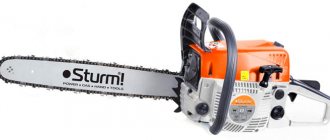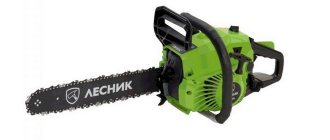Modern chainsaws are universally equipped with a saw attachment lubrication system. Moreover, a lot of attention is paid to this system.
Even in the operating instructions for modern gasoline (and electric) saws, the paragraph on chain lubrication often devotes several pages.
How to choose oil for a chainsaw chain, and how to correctly assess the operating conditions of the unit for the correct choice of lubricant?
There are many pitfalls and misconceptions in this issue, which, unfortunately, are firmly rooted in the minds of some people.
In this article we will try to dispel common myths about oils for lubricating chainsaw chains and talk about the intricacies of choice.
The role of oil in the operation of a chainsaw
In order to understand the role lubricants play, it is necessary to have a general idea of how the device operates. Although in a store, when purchasing, they usually say a few words about what it is and how it works, and which neck to pour what into, it would be useful to update simple information on this issue.
Engine oil
Without exception, all chainsaws, like their fellow lawn mowers and cultivators, are equipped with two-stroke engines. With small sizes they develop high power density. Due to the completion of the working cycle in two strokes, the speed of such engines also exceeds that of automobile engines. On the other hand, there is a heavy load on components and parts, air cooling, which also requires a safety margin in the design. The wear of elements can be reduced only by using high-quality lubricants.
A feature of two-stroke engines is the absence of an oil pan and a pump that would deliver liquid lubricant to all rubbing and interacting parts. The advantage of this scheme is its design simplicity, fewer units in the engine. On the other hand, the question arises of how to deliver lubricant to critical places, of which the most demanding are the cylinder and piston.
The solution was to add oil to the fuel. Gasoline is not poured into the saw tank in its pure form, but with the addition of lubricant in a certain proportion. Before entering the combustion chamber, this mixture washes the necessary components, and then exits the exhaust manifold in the form of exhaust gases.
Chain oil
A chain for a chainsaw is no less important than the engine.
For full and long-term operation, it also requires lubrication. Without it, the metal will very quickly begin to overheat, and then cease to perform its functions altogether. In addition, the oil supplied to the chain facilitates its movement when pulled through solid wood. By reducing resistance, you can achieve not only long chain life, but also reduce the load on the engine and reduce fuel consumption. At the same time, chain oil has fundamentally different characteristics from that which is mixed with gasoline.
Performance properties
Oiled or standard chain saw oil meets specific standards for density, viscosity, debris removal and other performance characteristics.
- Organic and mineral compositions do not differ significantly in their performance properties.
- Experienced users recommend working with organic consumables if the intervals between using the chainsaw do not exceed several days.
- The anti-corrosion and other protective properties of more expensive mineral oils are used if the tool is used for infrequent one-time work.
It is not difficult to check the oil for compliance with the outside temperature, and at the same time the lubrication system for serviceability. To do this, hold the saw head, running at medium speed, over a clean sheet of paper for a few seconds.
The width and saturation of the oil strip can be used to judge the suitability of the composition for long-term operation at a given air temperature and the performance of the built-in oil pump.
Features of lubricants for chainsaws
Most oils are susceptible to combustion because they contain hydrocarbons.
Mineral oil is actually a product of petroleum distillation. However, four-stroke engines have special mechanisms that prevent lubricant from penetrating into the cylinders. The reverse process, when the engine “eats oil,” leads to increased smoke formation and is considered a malfunction. In a two-stroke engine, everything happens the other way around - the oil must penetrate the combustion chamber and turn into smoke from the exhaust system. This led to a number of fairly stringent requirements for good chainsaw oil:
- Maximum complete combustion . The less smoke and soot produced when oil burns, the cleaner the channels through which exhaust gases pass will be. A very important requirement for manufacturers of oil for two-stroke engines is its environmental friendliness. A large amount of smoke and soot coming from the exhaust pipe can not only harm the environment. It is inhaled to one degree or another by the operator operating the tool. Therefore, oil that burns completely, with a minimum amount of smoke, is preferable for modern models of chainsaws.
- Purity and absence of impurities . The chainsaw carburetor is miniature in size. The channels through which the fuel mixture moves are so narrow that various foreign inclusions can partially block or even clog them.
- Combustion of the oil-gasoline mixture should occur with minimal soot formation . Otherwise, during regular operation, the working cylinder becomes coked: the resulting carbon deposits cover the walls of the combustion chamber and the piston, leading to wear of the cylinder bore. Operating such a motor becomes not only undesirable, but even dangerous.
- Oil should not only lubricate, but also clean interacting
- . This applies to a greater extent to synthetic fluids, whose performance characteristics are among the best on the market.
Manufacturers make colored oil for two-stroke engines. Dissolving in gasoline, it colors it pale pink or red. This way the operator can easily check whether he (or someone from his team) has forgotten to prepare the mixture in the required proportion
Consequences of using low-quality oil
Serious manufacturers of chainsaws indicate directly in the instructions for their products which oil to use with the device. Naturally, the company of the related products will be the same. This is not only a marketing ploy, but also a practical recommendation. Companies that have been producing saws for many years have sufficient production capacity and produce really good oils.
For many household chainsaw models, such advice is not available. The user equips the gas tank at his own discretion. And here it is also better to choose a quality product, tested by thousands of owners of gasoline units. Even an inexpensive saw with the correct operating modes and proper selection of consumables can last for more than one year. And vice versa: an unnamed oil of unknown composition can “kill” even a good Stihl or Husqvarna piston group.
If the exhaust system of the saw becomes clogged with particles of burning and soot, then the engine power will inevitably drop. Purge of the combustion chamber can no longer be carried out so intensively, most of the exhaust gases remain in the cylinder, and the fuel pump does not have enough strength to pump the required amount of mixture.
Incomplete combustion of the oil component in gasoline leads to the deposition of soot and carbon deposits in the cylinder and on the bottom of the piston. Poor fluidity indicators lead to heating of the cylinder-piston group, during which scuffing can form on the surface of the working parts. After several cycles of such work, it may be necessary to replace the piston.
Problems and their solutions
Knowing what kind of oil is needed for a chainsaw allows you to avoid the following series of typical problems:
- Decrease in efficiency.
- Chain jams.
- Clogged lubrication system.
- Wear of mechanisms.
- Engine malfunctions.
Note! Often, information about what kind of oil to pour into a chainsaw does not always save you from the malfunctions described above. The problem may lie in a clogged oil supply artery. The situation can be corrected by blowing or cleaning the channel, as well as replacing the internal oil filter.
Types of engine oil
Among the wide variety of lubricants, three large groups can be distinguished, which differ in both composition and characteristics:
- Mineral.
- Semi-synthetic.
- Synthetic.
- Mineral oils
One of the cheapest and most common. They are obtained during the refining of petroleum products. Many saws are kept in mineral oil for quite a long time. Its main advantage is price and availability. True, you can’t buy a good pure substance for pennies either. Mineral water can smoke the inside of the engine over time. However, if the owner is good with his hands, he can clean out all the “insides” himself. According to experienced “pilot operators”, with rare and not too intensive use of the unit, the mineral component is quite enough for normal operation.
- Synthetic oil
For two-strokes, it is made from artificially created components.
Industrial synthesis gives indicators unattainable with mineral oils. Synthetics are not afraid of cold, heat, or temperature changes. In addition, it forms much less soot. Recommended for use in professional equipment. in a logging site, where tools work for 8-10 hours almost without a break, the highest quality is the only way to maintain productivity. Semi-synthetics are a compromise solution for those who cannot afford pure synthetics, but the class of the tool does not allow them to add mineral water to gasoline. It is made on the basis of petroleum products, but contains special additives that improve the performance of the substance.
Review of famous brands of chainsaw engine oil
So, you shouldn’t pour anything into the chainsaw. For those who have not made a choice, there is always a time-tested assortment from different manufacturers that is familiar to the masses.
Stihl HP
Mineral composition with a high degree of purification. Color - dark red. Due to its organic origin, it has a limited shelf life - 4 years in unopened packaging. Be careful when purchasing: expired products may contain sediment. Several packaging volumes are available to the user: from 100 ml to 10 l. There are canisters with and without dispenser. Sometimes you can find a very small 20 ml bottle on sale. This volume is convenient for one-time use of the saw. The average price per liter is about 500 - 600 rubles.
Stihl HP Super
It belongs to the category of semi-synthetics, superior to regular HP in all respects, including price. It has a dark green color. It has low ash content. No carbon deposits on the piston and cylinder walls, as well as less smoky exhaust.
Stihl HP Ultra
This is already pure synthetics. It is the most advanced and expensive in the Shtil line. Also green, just a little lighter than Super. Suitable for motors of powerful professional tools. It is distinguished not only by maximum cleanliness, which benefits the engine and nature, but also by excellent frost resistance. Does not change its density and solubility in harsh conditions where logging is carried out. Available in 0.1, 1 and 5 liter containers. The cost of a liter is 1400 - 1500 rubles.
The German manufacturer is unlikely to clash with Greta Thunberg over its premium oil: HP Ultra disintegrates in open air within 21 days.
Husqvarna HP 2
The Swedish manufacturer does not spoil us with such variety as its German competitor. The branded oil available for purchase is a laconic dark package of 1 liter. Occasionally you can find 5 liter canisters. The color is green, the base is mineral, but with additives, so it would be logical to classify this product as semi-synthetic. The company is significantly silent about secret additives that not only minimize the amount of soot, but also help compensate for the low quality of fuel. The cost of a liter is about 600 - 650 rubles. The Swedes position their product as universal, suitable for both the household segment and professional equipment.
Oregon 90720S
The American brand, which produces chains and tires, could not stay away from the production of motor oil. True, these lubricants are not made in the States itself. The tricky wording “country of manufacture” is Russia or the USA. Being cheaper than the previous ones, this semi-synthetic product still holds its mark, demonstrating good purity and low ash content. Color - dark red, container - 1 and 5 liters, cost - about 450 - 500 rubles per liter.
Huter 2T
Universal oil for motorcycles, positioned as semi-synthetic, as it contains additives. Made in Russia, bottled in 1 liter containers. It is positioned as all-season, although at frost below 20 degrees it thickens noticeably. It is inexpensive (about 200 rubles) and is definitely a better option than nameless bottles with half-worn labels.
Oleo-Mac Prosint 2T
High-quality semi-synthetics in bright packaging. The cost of a liter on the market is from 500 to 600 rubles - not so little. But unlike cheaper analogues, it has API TC approval. It is not necessary to understand this; it is enough just to know that such oil has passed the appropriate certification and test system.
Hammer Flex 501-004
Another cheap semi-synthetic (250-300 rubles), which has received a certificate of conformity and the trust of users. The temperature limit for use is honestly indicated on the bottle: - 15 degrees. Most users who leave positive reviews do not put too much strain on the tool - there are more expensive oils for professional use.
What kind of chainsaw engine oil do you use?
MineralSynthetics
Features of chain oil
If the engine arsenal must have such properties as purity and low ash content, then chain oil must have completely different basic characteristics. It does not burn, so it is not required to be carbon-free after use.
The design of the saw set includes a bar with a driving and driven sprocket and a chain. Lubricating the blade facilitates its movement along the tire channel, the passage of the drive links along the sprockets, reducing wear on the rubbing pairs. Since the oil is applied to the surface of the chain in special holes or grooves, it must adhere well to the blade, since when the sprockets rotate, the centrifugal force will cause it to fly apart.
At maximum speeds such spread is inevitable. There is even an experiment to check the lubrication on the chain:
Apply full throttle, holding the tire over the fresh cut. Drops of oil that appear will indicate that there is enough lubrication.
Based on this, we can outline two most important characteristics of “chain” oils:
- Good adhesive ability . This means that the oil should stay as tightly as possible in the grooves and holes of the chain. At medium speeds it doesn't even leave the surface. Such indicators are related to viscosity - it is quite high for lubricants. At the same time, excessive thickness also harms the chain - the oil does not have time to envelop the chain in the required amount.
- Highly environmentally friendly . Chain oil ends up in nature almost unchanged, like from a bottle: it drips onto the ground, remains on wood, bushes, and grass. Once on the snow, in the spring it flows into a reservoir. Its impact may seem insignificant, but there are thousands of chainsaws operating all over the world. Large companies are very concerned about environmental issues. Therefore, they try to make their oils safe for the environment. Many of them are made from plant-based ingredients and disintegrate in a few days. Therefore, high-quality products have a limited shelf life.
Sprocket Lubricant
At the end of the chainsaw bar there is a driven sprocket, which ensures rotation of the chain. It also needs to be lubricated periodically. For this purpose, thick materials are used. You can use STIHL universal lubricant. Domestic lithol-based lubricants are also suitable. There is a special hole on the tire for lubricating the sprocket. You need to pump lubricant into it using a grease nipple or syringe.
Please note that if you frequently work with the toe of the tire, for example, when making grooves, the load on the sprocket increases and it needs to be lubricated more often.
Popular brands of oils for chainsaw chains
Stihl
The Germans traditionally offer several solutions:
- Forest Plus
Inexpensive for a branded product, but very effective. There will be no problems with it down to -15 degrees. Packaged in 1 and 5 liter containers. It retains its properties for three years, so when purchasing it, you need to consider how tightly you will use the saw.
- BioPlus
The name hints at the environmental friendliness of the lubricant. Plant origin makes the product completely safe for forests and water bodies. Biodegradable lubricants are at the peak of popularity in Europe, although in Russia they are still reluctant to shell out money for them.
- Synth Plus
Professional oil for real tough lumberjacks from countries with harsh climates. Although such forests are cut down mainly in Russia and Finland. The formula of the components allows it to work at -25, and the high price makes its use in household saws pointless.
Husqvarna
The Swedes have not remained aloof from “chain” lubricants. This segment offers two options:
- Bio Advanced
A universal solution, both for amateurs who value their efforts and tools, and among professionals for whom maximum speed and durability are vital. Biodegradation is a must.
- Vegoil
A more budget-friendly solution for the amateur sector. Positioned as an oil with reduced consumption. In practice, it is almost no different from competitors in terms of the speed of emptying the tank.
Other manufacturers
The oil is produced by many companies that also make chainsaws. Their products are less popular than Shtil or Husqvarna, but are also in demand among owners of gasoline units.
- Polar Lube
Mineral lubricant from the Italians Oleo-Mac.
- Champion
An adhesive lubricant that the manufacturer of the same name recommends for its power tools.
- Biotop
Following the global fashion for ecology, the Japanese company Makita decided to keep up.
If you have a saw that you don't want to lose, don't put car engine waste into the oil tank. Although this liquid still has lubricating properties, there is practically no adhesion. Everything around will be worked out. In addition, small particles of metal that accumulated in the waste while it was inside the 4-stroke internal combustion engine act on the chain, sprocket and tire like an abrasive.
For an expensive instrument, it is better to take high-quality consumables. For an inexpensive one, they are still of high quality, if the saw is not purchased for the purpose of a one-time job. Chain and engine oil is a way to both extend the life of a chainsaw and “kill” it faster.
Self-selection criteria
The problem of how to replace branded chain oil, which is not sold, is relevant for many peripheral regions. According to experts, the products of the famous brands Stihl and Husqvarna are a full-fledged analogue; they are identical in their main characteristics. Motor and chain oils from these manufacturers have proven themselves in all respects.
Considering the capabilities of the offered range, the consumer can make a choice in favor of a more expensive chain oil or its budget analogue. In addition to branded products, the list includes Enkor, Nanotech Standard and Nanotech Premium oils, which retain their operating properties at temperatures up to thirty ° C.
Versions of mineral-based oils are represented by the Makita and Makita Oregon brands, the same lubricating characteristics for organic chain oils Makita Biotop, Stihl Bio Plus, which are sold in packaging from one to twenty-five liters.
Most professional saws prefer one brand of lubricant. Constant use of one brand of oil allows you to study its capabilities and use them with maximum efficiency.
Sources:
https://benzopilatut.ru/maslo-dlya-smazki-cepi-benzopily-kakoe-i-kogda-lit/ https://opilah.com/maslo-dlya-tsepi-benzopily-kakoe-kuda-i-kogda- ispolzovat/











